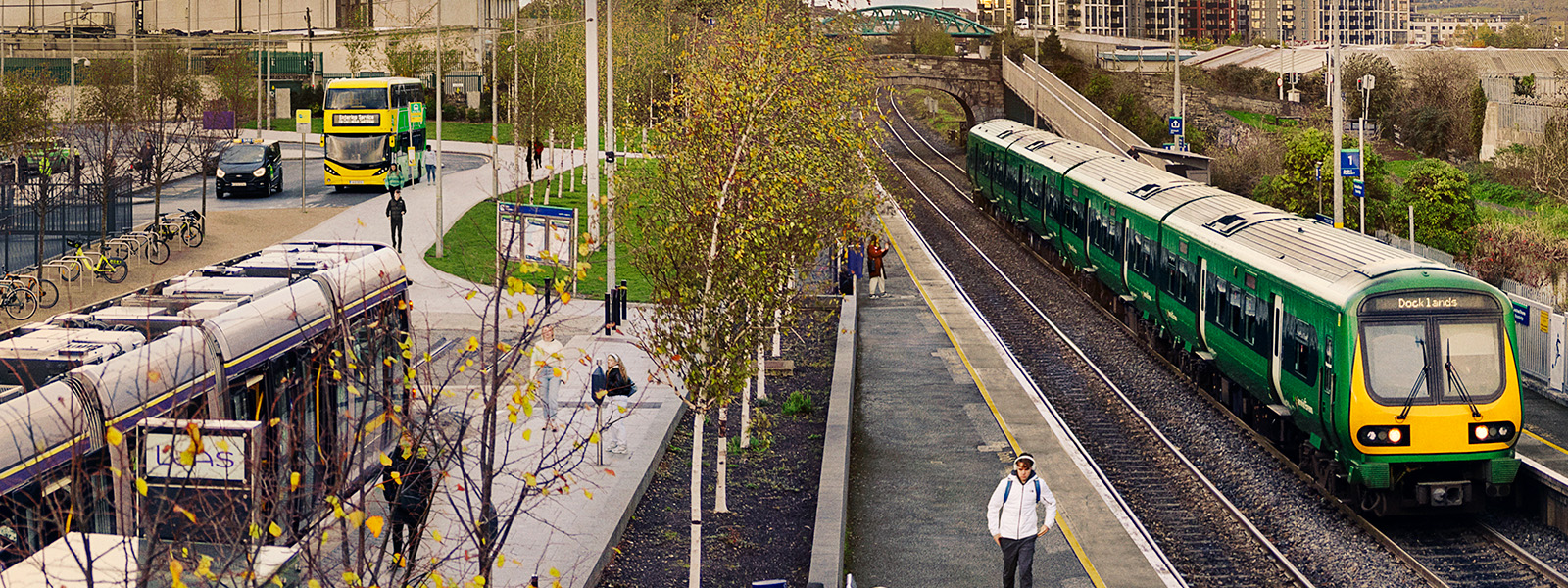Overall new network will enable more people to travel, to more places, more often
The level of bus services in the Dublin network will increase by 22% as a result of the Dublin Area Bus Network redesign, published today.
The redesigned bus network will provide a more coherently planned, higher capacity, more understandable network, delivering a better overall bus system for the Dublin region.
The redesign of the network was a key measure of the Transport Strategy for the Greater Dublin Area 2016-2035. It is among the measures in Project Ireland 2040 and is included as an action point in the Climate Action Plan, published earlier this year.
The plan was produced by the NTA and Dublin Bus with Jarrett Walker and Associates, (JWA).
Under the plan, the network will now be arranged on the basis of eight spines radiating from the city centre. Spines are very frequent routes made up of individual bus services timetabled to work together along a corridor. At the end of the spine, the individual services branch off to serve different areas.
An additional spine has been included in this plan to serve Howth and parts of the north-east city.
The plan also includes 10 orbital routes which will reduce significantly the need for passengers to travel into the city centre. Orbital services operate around the city, providing connections between suburbs and town centres, along with connections to rail, Luas and other bus routes. The inner orbital, the O for example, will operate two-way on the North and South Circular Roads at a frequency of every 8 minutes all day.
Northern orbitals (N2, N4, N8) – serving key locations such as Beaumont Hospital, DCU, Charlestown and Blanchardstown while Southern orbitals (S2, S4, S6, S8) – will serve Ballsbridge, Rathmines, Heuston, UCD, Crumlin Hospital, Liffey Valley, Dundrum and Tallaght. Orbitals (W2, W4, W8) – serving key locations like Liffey Valley, Clondalkin Village and Tallaght to the west.
In addition, a number of city-bound services operating into Dublin City Centre are included in the plan. These are services that are not part of any spine and operate on their own timetable as part of the network.
There will also be significant additions to evening and weekend services with all frequent routes operating every 15 minutes or better between 6am and 11pm on weekdays. All frequent routes will also retain this service on Saturdays, and most will have this on Sunday as well. There is also provision for local services providing important connections within local areas, linking to local retail centres and to onward transport connections.
Additional peak-time services are included in the plan, operating during the busiest time of the day generally weekday mornings and evenings.
Last year, NTA published a draft network review which went out to public consultation. The NTA received submissions, petitions, emails and letters from some 50,000 people.
A key challenge in many areas was to increase the level of direct service without undermining the integrity of the new network. In many cases this was achieved by reconfiguring the branches at the end of the Spines to provide more direct routes to the city centre.
Concerns relating to particular linkages to schools, hospitals or shops have been addressed through various route adjustments and additional radial routes have been added to address particular issues.
Consultation on this revised plan begins today and will run to Tuesday 3rd December 2019.
NTA has produced local brochures for each of 29 areas in the bus network, in both Irish and English. The brochure gives details as to what bus services will be provided for people in the particular area, along with a local map and details of the consultation process.
All brochures are available on the www.busconnects.ie website, but every household and commercial property will receive a copy of the relevant brochure for that area. That’s a total of 650,000 brochures. Delivery of those brochures begins today, and will be completed for all areas of Dublin within 15 working days.
A Route Mapper Tool has been developed for people to use to find details of the new network for a journey. That tool is available on www.busconnects.ie
NTA will host a series of eight two-day information events across the region during November. Dates, times and venues are available at www.busconnects.ie
Anne Graham, NTA Chief Executive Officer said:
“Last year, we published for public consultation, our draft network plan. The level of engagement we saw from members of the public in that process was unprecedented, and it provided us with the kind of insight into our bus services, that cannot be garnered any other way.
We have responded very constructively to the issues that were raised, and I have no doubt that the plan we are publishing today is one that will increase overall services levels for bus customers. It will also make the bus network more useful to more people and will make all parts of Dublin more accessible than ever before.”
Ray Coyne, Dublin Bus Chief Executive Officer said:
“This revised network design is part of an ambitious and welcome investment of €1.5 billion in Dublin’s bus system. The views of our 143 million customers and people across the Greater Dublin area are clearly reflected in this revised network redesign.
This is also a significant opportunity to continue the growth and success of Dublin Bus and the city. It is clear from BusConnects that urban bus public transport is key to developing a modern, dynamic public transport network and harnessing the strong economic growth experienced over the last few years. With over 3 million extra customers carried by Dublin Bus in 2018, we will build on the strengths of this proposed network to the benefit of the city and our customers.”
